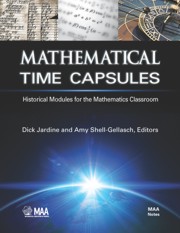Book contents
- Frontmatter
- Preface
- Contents
- 1 The Sources of Algebra
- 2 How to Measure the Earth
- 3 Numerical solution of equations
- 4 Completing the Square through the Millennia
- 5 Adapting the Medieval “Rule of Double False Position” to the Modern Classroom
- 6 Complex Numbers, Cubic Equations, and Sixteenth-Century Italy
- 7 Shearing with Euclid
- 8 The Mathematics of Measuring Time
- 9 Clear Sailing with Trigonometry
- 10 Copernican Trigonometry
- 11 Cusps: Horns and Beaks
- 12 The Latitude of Forms, Area, and Velocity
- 13 Descartes' Approach to Tangents
- 14 Integration à la Fermat
- 15 Sharing the Fun: Student Presentations
- 16 Digging up History on the Internet: Discovery Worksheets
- 17 Newton vs. Leibniz in One Hour!
- 18 Connections between Newton, Leibniz, and Calculus I
- 19 A Different Sort of Calculus Debate
- 20 A ‘Symbolic’ History of the Derivative
- 21 Leibniz's Calculus (Real Retro Calc.)
- 22 An “Impossible” Problem, Courtesy of Leonhard Euler
- 23 Multiple Representations of Functions in the History of Mathematics
- 24 The Unity of all Science: Karl Pearson, the Mean and the Standard Deviation
- 25 Finding the Greatest Common Divisor
- 26 Two-Way Numbers and an Alternate Technique for Multiplying Two Numbers
- 27 The Origins of Integrating Factors
- 28 Euler's Method in Euler's Words
- 29 Newton's Differential Equation ẏ/ẋ = 1 − 3x + y + xx + xy
- 30 Roots, Rocks, and Newton-Raphson Algorithms for Approximating √2 3000 Years Apart
- 31 Plimpton 322: The Pythagorean Theorem, More than a Thousand Years before Pythagoras
- 32 Thomas Harriot's Pythagorean Triples: Could He List Them All?
- 33 Amo, Amas, Amat! What's the sum of that?
- 34 The Harmonic Series: A Primer
- 35 Learning to Move with Dedekind
- About the Editors
8 - The Mathematics of Measuring Time
- Frontmatter
- Preface
- Contents
- 1 The Sources of Algebra
- 2 How to Measure the Earth
- 3 Numerical solution of equations
- 4 Completing the Square through the Millennia
- 5 Adapting the Medieval “Rule of Double False Position” to the Modern Classroom
- 6 Complex Numbers, Cubic Equations, and Sixteenth-Century Italy
- 7 Shearing with Euclid
- 8 The Mathematics of Measuring Time
- 9 Clear Sailing with Trigonometry
- 10 Copernican Trigonometry
- 11 Cusps: Horns and Beaks
- 12 The Latitude of Forms, Area, and Velocity
- 13 Descartes' Approach to Tangents
- 14 Integration à la Fermat
- 15 Sharing the Fun: Student Presentations
- 16 Digging up History on the Internet: Discovery Worksheets
- 17 Newton vs. Leibniz in One Hour!
- 18 Connections between Newton, Leibniz, and Calculus I
- 19 A Different Sort of Calculus Debate
- 20 A ‘Symbolic’ History of the Derivative
- 21 Leibniz's Calculus (Real Retro Calc.)
- 22 An “Impossible” Problem, Courtesy of Leonhard Euler
- 23 Multiple Representations of Functions in the History of Mathematics
- 24 The Unity of all Science: Karl Pearson, the Mean and the Standard Deviation
- 25 Finding the Greatest Common Divisor
- 26 Two-Way Numbers and an Alternate Technique for Multiplying Two Numbers
- 27 The Origins of Integrating Factors
- 28 Euler's Method in Euler's Words
- 29 Newton's Differential Equation ẏ/ẋ = 1 − 3x + y + xx + xy
- 30 Roots, Rocks, and Newton-Raphson Algorithms for Approximating √2 3000 Years Apart
- 31 Plimpton 322: The Pythagorean Theorem, More than a Thousand Years before Pythagoras
- 32 Thomas Harriot's Pythagorean Triples: Could He List Them All?
- 33 Amo, Amas, Amat! What's the sum of that?
- 34 The Harmonic Series: A Primer
- 35 Learning to Move with Dedekind
- About the Editors
Summary
Introduction
In today's world of electronic clocks and universal calendars, it's easy to forget how important mathematics used to be just for the fundamental task of figuring out what time it was. The standard rigorous approach to the problem involved applying trigonometry to observed positions of the sun or the stars, as described below (“In the Classroom”). But several simpler methods were also developed for use when observations were unavailable or calculation was unappealing. One such practical device was the sinking-bowl water-clock, used for many centuries in India. Students (and teachers) will be impressed by how easy such a clock is to construct and adjust, and how much mathematical labor it can save.
This activity and discussion can be used as part of a module on trigonometry. A more advanced class in calculus may be interested in the theoretical modeling of water-clock construction, and especially in comparing the real mathematics of water-clock design with the artificial assumptions made in typical “related rates” problems about filling and draining water tanks. The construction and testing of the sinking-bowl model can take as little as ten or fifteen minutes (depending on the length of its period): exploring the trigonometry of time-telling may involve fifteen or twenty minutes more.
Historical Background
Any water-clock (or “clepsydra”, Greek for “stealing water”) works on more or less the same principle as an hourglass: it measures a fixed period or interval of time by means of a substance flowing through a hole in a container, and at the end of that interval it must be reset manually to measure another period of the same length.
- Type
- Chapter
- Information
- Mathematical Time CapsulesHistorical Modules for the Mathematics Classroom, pp. 55 - 62Publisher: Mathematical Association of AmericaPrint publication year: 2011
- 1
- Cited by



